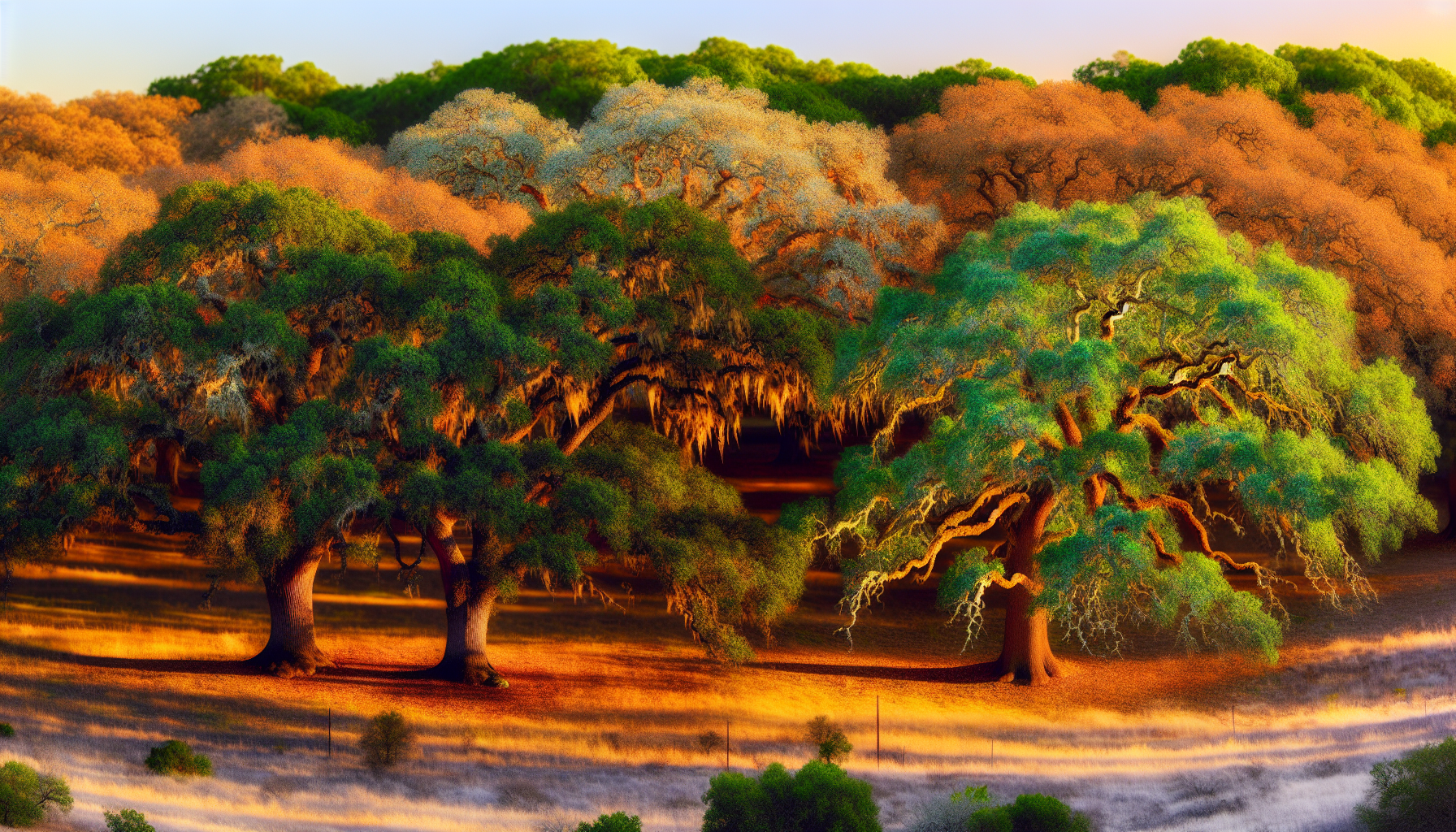Growing an oak tree is a journey of patience and time. How long does it take an oak tree to grow? The answer varies, with initial growth spurts happening in the first decade or two, while full maturity can stretch over several decades or more, depending on the oak species and specific environmental factors. This article dives into the stages of oak development, the influential elements of growth, and what one can anticipate as these venerable trees rise throughout the years.
Key Takeaways
Oak tree growth rates vary by species and environmental conditions, with some growing to full height within 20-30 years while others take up to 50 years, depending on factors like soil, climate, and type of oak.
Oak trees have a life cycle that spans from acorn germination to a mature stage that can last several centuries, with each phase requiring specific environmental conditions and care practices for optimal growth.
Caring for oak trees involves appropriate watering, soil management, and pruning during non-vulnerable periods, while also addressing pests and diseases to promote a healthy life cycle from acorn to mature tree.
Understanding Oak Tree Growth Rates

The journey to becoming a towering oak tree is a fascinating process, with growth rates varying depending on the oak species and environmental conditions. It’s a journey that begins with a tiny acorn and culminates in a mighty oak tree, with the fastest growth occurring in the first 10-15 years of the tree’s lifespan.
The growth rates of oak trees are influenced by several factors, including:
The type of oak species
Soil conditions
Climate
Environmental factors
In the upcoming subsections, we’ll delve into the specifics of fast and slow-growing oak species and the environmental factors that impact growth.
Fast-Growing Oak Species
Among the diverse genus Quercus, certain oak species are known for their fast growth. The Northern Red Oak (Quercus rubra), for instance, can grow up to 75 feet tall and is recognized for its swift growth and vibrant red autumn leaves. Another fast-grower is the Pin Oak (Quercus palustris Green Pillar) that is recognized for its rapid growth, with a growth rate of two feet or more per year. These species are known to increase by 12’-15’ over a period of 5 to 7 years, growing approximately twice as fast as the White Oak, another common oak species.
Other fast-growing oak species include most oak trees, such as:
Willow Oak (Quercus phellos): can grow to 60 feet tall and is renowned for its unique willow-like leaves and gold to orange fall foliage
Scarlet Oaks (Quercus coccinea): renowned for their rapid growth and serve as excellent shade trees, reaching up to 80 feet tall
Nuttall Oaks (Quercus nuttallii): renowned for their rapid growth and serve as excellent shade trees, reaching up to 80 feet tall
These fast-growing deciduous trees, with their quick growth and beautiful autumn foliage, offer an excellent choice for those eager to see the results of their tree-planting efforts sooner, making them a popular ornamental tree among various tree species.
Slow-Growing Oak Species
On the other end of the spectrum, there are certain oak species that grow at a slower pace. White oak (Quercus alba), for instance, is a notable example of a slow-growing oak species. These oaks typically grow 12 to 15 feet over a 10 to 12 year period and can potentially reach heights of around 80 feet. Despite this slower growth rate, they are highly valued trees within their ecosystems, providing food for wildlife and enhancing the overall biodiversity.
The slower growth rate of these oak species should not be seen as a disadvantage. On the contrary, it’s an attribute that contributes to their strength and durability, giving them the ability to withstand harsh weather conditions and pests. While they may take longer to reach their full height and spread, their longevity, sturdiness, and the ecological benefits they provide make them worth the wait.
Environmental Factors Affecting Growth
The growth of oak trees is significantly influenced by various environmental factors. Some key factors that impact the growth of oak trees include:
Soil conditions: Black oaks, for instance, are capable of tolerating very dry soil conditions, which can significantly impact their growth and ability to thrive.
Seasonal changes: The overall growth cycle of oak trees is affected by seasonal changes in soil moisture and temperature. Mediterranean climates, for example, showcase profound variations.
Evergreen vs deciduous oaks: Evergreen oaks have an adaptive advantage in environments with low soil water availability as they resume growth after dry periods, unlike deciduous oaks which experience more constrained growth during dry springs.
Understanding these environmental factors is important for ensuring the successful growth and health of oak trees.
In addition to soil and climate, projected climate warming is expected to reduce the radial growth of both evergreen and deciduous Mediterranean oaks, particularly in drier locations. Environmental conditions play a crucial role in the fluctuations of their growth rates throughout their lifespan. It’s important to remember that even though oak trees are hardy, they still require certain environmental conditions to thrive. Understanding these conditions can help in maintaining the health and longevity of these magnificent trees.
The Life Cycle of an Oak Tree

The life cycle of an oak tree is a fascinating journey. It includes the following stages:
Acorn
Sapling
Full-grown tree
Senescence or ancient stage
This process, which many wonder how long does it take, can span from 100 to 300 years and is influenced by a variety of factors and conditions. Each stage demands different care and attention.
Let’s delve deeper into the life cycle stages of an oak tree – the acorn germination, sapling stage, and mature tree stage.
Acorn Germination
The journey of an oak tree begins with the germination of an acorn. This process occurs when an acorn falls to the ground and the conditions are right for growth to start. For successful germination, acorns typically require a period of cold stratification to simulate winter conditions and break seed dormancy, although this requirement varies among different oak species. The root radicle is the first part of the acorn to emerge during germination, anchoring the future oak tree into the soil.
To foster successful germination, it is crucial to select viable acorns by soaking them in water and discarding any that float, which indicates damage or emptiness. Viable acorns will sink in water, and this method can be used to rehydrate them if they have been stored for a period before planting. In essence, the germination process is a delicate balance of the right conditions and proper cultivation methods, paving the way for the growth of a mighty oak tree.
Sapling Stage

After the germination of the acorn, the oak seedling progresses to the sapling stage. This stage is crucial for establishing a strong foundation for the oak tree’s future growth, marking the transition from a small seedling to a young tree with increased height and a developing woody stem. During this stage, regular, measured watering and keeping the area around the base free of weeds and grass are important for proper growth and survival.
At this stage, oak saplings are more susceptible to damage from environmental factors such as extreme weather, pests, and competition from other plants. Transplanting is done when the seedlings reach 5-6 inches tall or outgrow their containers, with the stronger sapling retained if multiple seedlings germinate in the same pot. The sapling stage, thus, is a crucial phase during which the tree establishes its roots and starts building its structure for future growth.
Mature Oak Tree
Following the sapling stage, the oak tree enters the mature stage, where it develops a substantial canopy and a robust root system, results of decades of growth influenced by the species and the environment. A mature oak tree is recognized by its thick and sturdy trunk, expansive root system, and a wide-reaching canopy. The mature stage of an oak tree embodies strength and endurance, with some species, like the white oak, known to live for over 600 years.
Mature oak trees are not just about majestic size and longevity; they also play a crucial role in the ecosystem. They provide habitat and food for wildlife, influence microclimate, and contribute to soil health through decomposing leaf litter. As keystone species, mature oaks support entire ecological communities, enhancing biodiversity.
A mature oak tree is, thus, not just one oak tree but a vibrant ecosystem where oak trees live and thrive.
Oak Trees Across the United States: Regional Differences

From the Eastern to the Western United States, oak trees show intriguing regional variations. The rich tapestry of oak species across the country is shaped by diverse climates and environmental conditions, each offering unique growth patterns and characteristics.
Let’s explore the oak species native to the Eastern, Southern, and Western regions of the United States, including those that produce white oak acorns.
Eastern Oaks
In the Eastern United States, species such as Chinkapin and Bur Oak are commonly found. These species are tolerant of the alkaline soils typically found in this region. Apart from their adaptability to soil conditions, Eastern Oaks are a preferred source of food for wildlife due to their production of smaller acorns which have lower tannin levels.
The Eastern Oaks:
Have tolerance to varying soil conditions
Play a valuable ecological role
Contribute to the landscape’s beauty
Support the local wildlife
Play a significant role in maintaining the region’s biodiversity
Southern Oaks
In the Southern United States, several oak species are native. Among these, the commonly found oak species include:
White Oaks
Southern Red Oaks
Chestnut Oak (previously Chestnut Oaks)
Georgia Oaks
Overcup Oaks
Shumard Oaks
Swamp Chestnut Oaks
Live oak trees are particularly popular for being evergreen and thriving in USDA zones 7-10. These oak species thrive in various soils, adapting to the conditions of the Southern US.
These Southern Oaks, with their varying heights and adaptability to various soils, play a crucial role in the Southern landscapes. Their versatility and hardiness make them a valuable part of the region’s ecosystem, contributing to the region’s rich biodiversity and offering excellent shade for the hot Southern summers.
Western Oaks
The Western United States is home to several unique oak species. Among these, the Blue Oak (Quercus douglasii) stands out, with the following characteristics:
Typically reaching heights of 20-60 feet
Displaying a remarkable lifespan of 175-450 years
Blue-gray leaves, varying in size and may range from smooth to deeply lobed, adding a distinctive touch to the landscape.
The Western Oaks, particularly the Blue Oak, are long-lived trees that add charm to the Western landscape. Their unique characteristics and adaptability to the region’s conditions make them an integral part of the Western ecosystem, contributing to the biodiversity and aesthetic value of the region.
Caring for Your Oak Tree: Tips for Optimal Growth
Even the hardiest oak trees require proper care to reach their full potential. From the initial planting to ongoing maintenance, each stage of your oak tree’s life requires different types of care. Let’s explore the best practices for watering and soil management, pruning and maintenance, and pest and disease control to ensure your oak tree grows strong and healthy.
Watering and Soil Management
To ensure healthy growth, oak trees require proper watering techniques and soil management. Here are some tips to follow:
Mulch should be applied to oak trees in a bowl shape, extending to the drip line, with a 2-4 inch thickness. Avoid direct contact with the trunk to prevent rot and disease.
After planting an oak tree, water it daily for the first few weeks.
Then, reduce the frequency to weekly twelve weeks after planting.
Ultimately, water an established oak tree once each month.
By following these tips, you can help your oak tree thrive.
Soil quality also plays a significant role in the health and growth of your oak tree. Oak trees thrive best in slightly acidic soil, with a pH typically between 3.6 and 7. Soil preparation can be enhanced using special additives, compost, and manure to increase beneficial fungi.
In urban environments, it’s beneficial to add mycorrhizal fungi to the soil around oak trees to aid in nutrient and water absorption and to enhance overall tree health.
Pruning and Maintenance
Pruning and maintenance are essential components of oak tree care, ensuring optimal growth and longevity. The best time to prune oak trees is from late fall to early spring, between November 1st and March 31st. Pruning is recommended every 2-3 years for their health and longevity. Here are some tips for pruning oak trees:
Prune young oak saplings to form an attractive shape and to remove branches with narrow crotches, preventing splitting as the tree matures.
Remove any dead, damaged, or diseased branches.
Thin out crowded branches to improve air circulation and sunlight penetration.
Avoid pruning during the summer months when oak wilt disease is most active.
Use proper pruning techniques, such as making clean cuts and avoiding excessive pruning.
By following these guidelines, you can ensure the health and beauty of your oak trees.
Before pruning, it is essential to consult local regulations and possibly obtain permits, as many cities have tree ordinances, and a tree specialist should be consulted to ensure proper practices are followed. Pruning and maintenance, when done right, can significantly contribute to the health, growth, and longevity of your oak tree, ensuring it reaches its full potential.
Pest and Disease Control
Pests and diseases can pose significant threats to oak trees, particularly during their early growth stages. Protecting oak seedlings and saplings from pests is essential since early pest management prevents future health issues. Oak trees may suffer from pests such as carpenterworms, imported gypsy moths, and acorn weevils, and diseases like oak wilt, honey fungus, and powdery mildew which can threaten their growth and survival.
To prevent common oak tree diseases such as oak wilt, avoid pruning during the summer months when beetles are more active, and be cautious not to over-mulch as it can lead to an array of health issues. Pest and disease control, therefore, is a crucial aspect of oak tree care, helping to ensure your tree stays healthy and robust throughout its life cycle.
Oak Tree Growth Timeline: From Acorn to Mighty Oak
The growth timeline of an oak tree is a fascinating process, starting from a tiny acorn and ending as a majestic oak tree. This timeline, which can span several decades, includes stages such as germination and early growth, sapling development, and acorn production. Understanding the process of growing oak trees can provide valuable insights into their life cycle and care.
Let’s delve into each of these stages and understand the journey of an oak tree from an acorn to a mighty oak.
Germination and Early Growth
The journey of an oak tree begins with the germination of an acorn. This process, which occurs in the autumn when the acorn falls to the ground, is influenced by soil moisture and temperature conditions. The root radicle is the first part of the acorn to emerge during germination, marking the start of the tree’s development.
Once germination occurs, the oak seedling develops a taproot within the first year to anchor itself and starts to grow its first leaves for energy, prioritizing root growth over above-ground expansion early on. These early stages of growth lay the foundation for the future growth and development of the oak tree.
Sapling Development
After the germination of the acorn, the oak seedling progresses to the sapling stage. This stage is crucial for establishing a strong foundation for the oak tree’s future growth, marking the transition from a small seedling to a young tree with increased height and a developing woody stem. At this stage, the oak sapling exhibits the following characteristics:
Increased height
Developing woody stem
Larger and increased number of leaves
Greater food production through photosynthesis
These changes are crucial for the tree’s growth and health.
An expanding and strengthening root system is a key characteristic of the sapling stage as it provides the necessary support for the oak tree’s continued growth. Rapid vertical growth and the initiation of branches spreading are pivotal in developing the broad and spreading crown typical of mature oak trees. This stage, therefore, is a critical period during which the tree establishes its roots and starts building its structure for future growth.
Acorn Production

An important milestone in the life of an oak tree is when it begins producing acorns. Oak trees generally start producing acorns at around 20 years of age, but some species may produce acorns as early as within the first five years. Certain oak species like white oak and live oak produce acorns that mature within one year, contrasting with species such as red oak and pin oak that require two years.
Acorn production in oak trees follows a cycle with mast years occurring every 2 to 3 years, during which there is a boom in acorn production, although the acorns tend to be smaller. An oak tree reaches optimal acorn production typically between 50 to 80 years of age, after which the output begins to wane.
The production of red oak acorns is a significant phase in the life of an oak tree, signaling its maturity and readiness to contribute to the next generation of oak trees when acorns fall.
Oak Trees in Urban Landscapes: Challenges and Solutions
While oak trees are hardy and adaptable, they can face certain challenges in urban landscapes. From space constraints to varying soil quality and environmental stressors, these challenges can impact the growth and health of oak trees. However, with the right care and solutions, oak trees can thrive in urban landscapes, providing not just aesthetic value but also contributing to the urban ecosystem.
Space Constraints
One of the key challenges for oak trees in urban landscapes is space constraints. Providing adequate space for an oak sapling to grow is crucial to avoid future issues with crowding and competition for resources, ensuring healthy development both above and below ground.
Careful planning and strategic placement can help overcome these space constraints, allowing your oak tree to grow and thrive even in an urban landscape.
Soil Quality
Soil quality is another critical aspect that influences the growth of oak trees in urban landscapes. Urban soil frequently differs from the natural soil environment in which oaks thrive, with key variations in moisture levels, mineral content, and organic matter composition.
To improve soil quality in urban landscapes, it is crucial to tailor soil amendments and interventions to address these specific challenges such as moisture control, mineral enrichment, and enhancement of organic content.
Pollution and Environmental Stressors
Lastly, pollution and environmental stressors present another set of challenges for oak trees in urban landscapes. Oak trees in urban areas face space limitations that hinder vital processes such as water uptake and evapotranspiration. Furthermore, the use of rocks as mulch around urban oak trees can lead to soil desiccation and heat absorption, creating a stressful environment for tree growth.
However, with careful planning and maintenance, these challenges can be mitigated, allowing your oak tree to grow and thrive despite the urban challenges.
Summary
From a tiny acorn to a towering oak tree, the journey of an oak tree is a fascinating process filled with numerous stages and challenges. Understanding the growth rates, life cycle, and the care needed at each stage can help us better appreciate these magnificent trees and allow us to provide them with the best possible care, whether in a forest or an urban landscape. As we have seen, these majestic trees not only add beauty and shade to our landscapes but also contribute significantly to our ecosystem. Let us continue to care for and cherish these mighty oaks, for they are not just trees, but a vibrant testament to strength, endurance, and the power of nature.
Frequently Asked Questions
How big will an oak tree get in 10 years?
An oak tree can grow 12′-15′ in a 10 to 12 year period, reaching a height of around 80 feet. Plan on this growth if you’re considering planting an oak tree.
What is the lifespan of an oak tree?
The lifespan of an oak tree varies by species, with an average range of 100 to 300 years, but some species can live for shorter or longer periods. (No date)
How tall will an oak tree be in 20 years?
A white oak tree will mature to a height of 65-85 feet with a canopy spread of almost the same width in 20 years.
How fast do oak trees grow?
Oak trees can grow from 1 to 3 feet per year and are fastest in the first 10 or 15 years, with young oak trees reaching a growth rate of 2 to 3 feet per year.
Are there different growth rates among oak species?
Yes, certain oak species like Pin Oak and Northern Red Oak grow faster than others like the White Oak, resulting in different growth rates.




